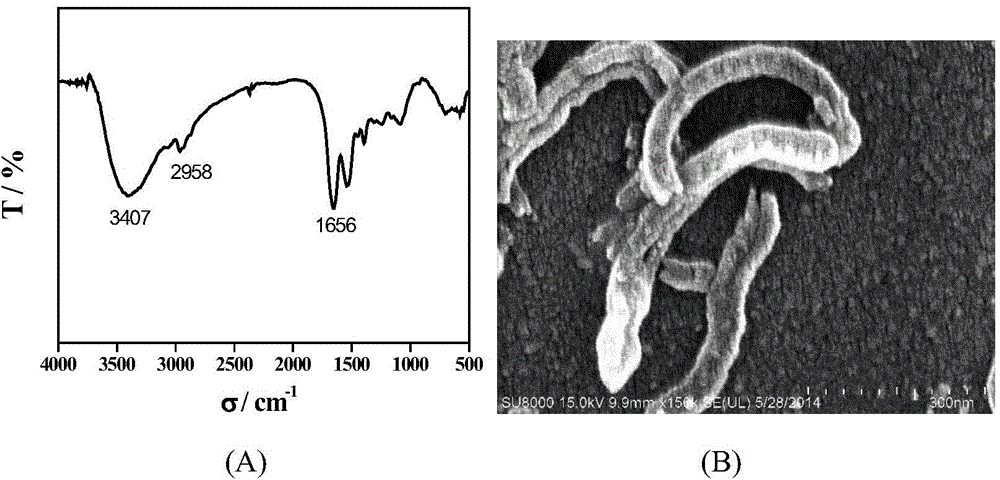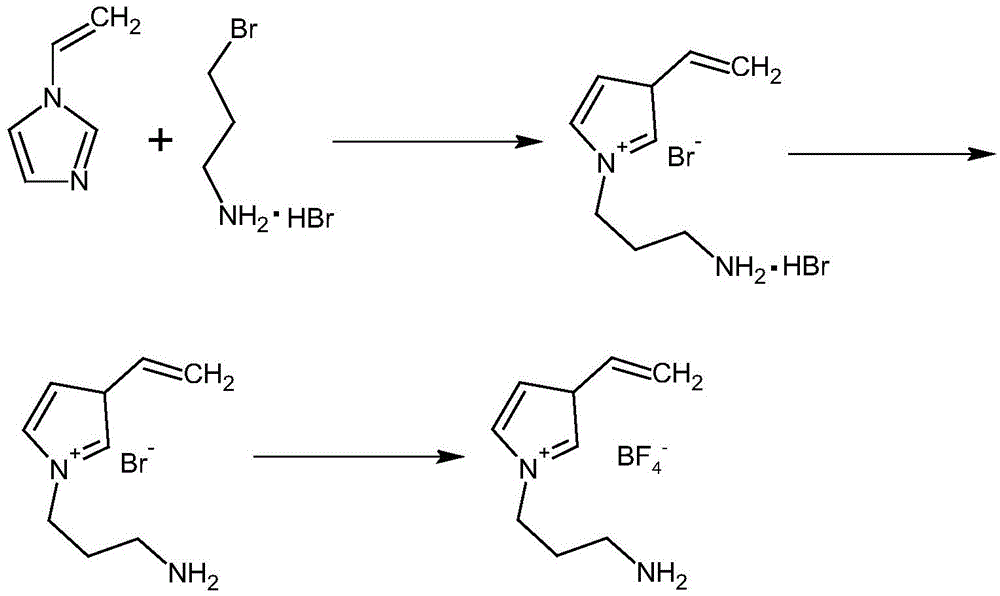Protein molecular imprinting polyion liquid membrane electrochemical transducer
An ionic liquid and protein technology, used in the synthesis of functionalized ionic liquids and the preparation of protein molecularly imprinted electrochemical sensors, can solve the problems of poor selective recognition of proteins, no biocompatibility, complicated and time-consuming operations, etc. , to achieve good water solubility and biocompatibility, good stability and repeatability, and good selectivity.
- Summary
- Abstract
- Description
- Claims
- Application Information
AI Technical Summary
Problems solved by technology
Method used
Image
Examples
Embodiment 1
[0044] A carboxylated multi-walled carbon nanotube, the preparation method of which is as follows:
[0045] 50mg multi-walled carbon nanotubes (MWCNT) dissolved in 6mL4mol L -1 Nitric acid, heated to reflux for 24h. After the reaction was completed, the acidified product was washed by centrifugation with acetonitrile to pH 7, then washed with ethanol, and dried at 25°C. Its FT-IR spectrum as figure 1 As shown in (A), the SEM pattern is as figure 1 (B) shown.
Embodiment 2
[0047] A glassy carbon electrode modified by carboxylated multi-walled carbon nanotubes, the preparation method of which is as follows:
[0048] Polish the glassy carbon electrode with a diameter of 3mm to a bright mirror surface on a polishing cloth with alumina powder with a particle size of 0.05 μm, rinse it with secondary water, and then use nitric acid solution (65wt% nitric acid mixed with secondary water in equal volumes) solution), absolute ethanol and secondary water for 2 min, and finally with N 2 Blow dry and set aside. Weigh a certain amount of carboxylated multi-walled carbon nanotubes (MWCNT-COOH) prepared in Example 1, add them into secondary water, and disperse them uniformly by ultrasonic, so that the concentration of MWCNT-COOH is 0.5 mg·mL -1 . Use a pipette to draw 6.0 μL MWCNT-COOH solution and drop-coat it on the surface of the glassy carbon electrode, and dry it at room temperature to obtain a carboxylated multi-walled carbon nanotube-modified glassy c...
Embodiment 3
[0050] 1-vinyl-3-aminopropylimidazolium tetrafluoroborate ionic liquid, its synthesis method is as follows:
[0051] Dissolve 4.4g of 3-bromopropylamine hydrobromide (CAS No.: 5003-71-4) in 30mL of anhydrous acetonitrile, N 2 protection, raised the temperature to 55°C, then added 30mL of anhydrous acetonitrile solution containing 2.8g N-vinylimidazole dropwise in 2h, then continued to react for 12h, removed the solvent, added water and toluene twice for washing, and separated the liquid The aqueous layer was dissolved in methanol and Na was added dropwise 2 CO 3 Saturated methanol solution to pH 9. Evaporate the solvent, add a saturated solution of sodium tetrafluoroborate to the product, stir for 1 h, remove water by evaporation, wash with methanol centrifugally, and evaporate methanol to obtain light yellow 1-vinyl-3-aminopropylimidazolium tetrafluoroborate ionic liquid.
[0052] Product characterization results: 1H NMR (D 2 O)δ: 9.07(s, 1H), 7.75(s, 1H), 7.58(s, 1H), 7....
PUM
| Property | Measurement | Unit |
|---|---|---|
| diameter | aaaaa | aaaaa |
Abstract
Description
Claims
Application Information
 Login to View More
Login to View More - R&D
- Intellectual Property
- Life Sciences
- Materials
- Tech Scout
- Unparalleled Data Quality
- Higher Quality Content
- 60% Fewer Hallucinations
Browse by: Latest US Patents, China's latest patents, Technical Efficacy Thesaurus, Application Domain, Technology Topic, Popular Technical Reports.
© 2025 PatSnap. All rights reserved.Legal|Privacy policy|Modern Slavery Act Transparency Statement|Sitemap|About US| Contact US: help@patsnap.com



